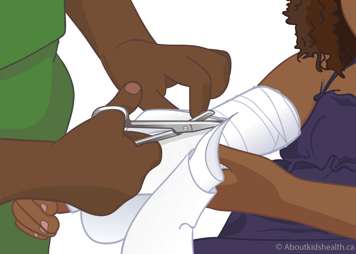About your child's cast
Casts and splints hold a part of the body in place. They are used to treat a suspected injury, a fracture or other medical conditions. Casts are put on by an orthopaedic technologist or doctor. All casts are made of plaster or fibreglass with soft cotton underneath to protect the skin.
The plaster cast
- When applied, the plaster may feel warm at first. This is normal.
- The cast will feel firm to touch in 10 to 15 minutes, but it will take up to 48 hours (2 days) to dry all the way through.
- While drying, the cast may feel cold and clammy until it dries all the way through.
- Plaster casts are not waterproof or water resistant.
- Plaster casts and splints are covered by your provincial health insurance in Ontario.
The fibreglass cast
- Fibreglass is applied the same way as plaster.
- Fibreglass dries in about 1 hour. It is lighter in weight and stronger than plaster.
- Fibreglass casts are water resistant but are NOT waterproof.
- In some cases, fibreglass casting may be used with waterproof liner to make a waterproof cast. Ask your orthopaedic technologist if your child may be eligible for a waterproof cast.
- There is a charge for fibreglass casts and other orthopaedic devices.
Signs of a problem with your child's cast
Look at your child’s cast four or five times per day. Seek urgent medical advice if your child has any of the following complications:
Fingers or toes that are blue, white or very swollen
Your child’s fingers or toes should be warm and normal in colour. You can compare the temperature, colour and size with your child’s other arm or leg.

Your child should not wear nail polish or rings while wearing a cast. You need to be able to see if the nails are blue.
Smells and odours from the cast
It is normal for casts to start to smell if they have been in place for a long time. We worry about bad or foul smells, as they may indicate an infection under the cast.
A cast that feels tight to your child
If your child’s cast feels tight, it may mean that the arm or leg is swollen inside the cast. The swelling can make it difficult for blood to circulate through the arm or leg.
A cast that is causing pain to your child
If your child is complaining of a persistent pain, often described as burning, pushing or squeezing, it may mean that there is pressure against the skin underneath the cast. This may be in a different location than your child’s injury.
A cast that is soft or broken
If the cast is soft or broken, it may need to be repaired or replaced.
Taking care of your child at home
The cast will change how your child uses the arm or leg. They will not be able to use it normally.
Please follow all the instructions you were given about how much physical activity your child should be doing with the cast on.
Taking care of your child's cast at home
- Keep your child's cast clean and dry.
- If possible, try to bathe your child using a cloth or sponge with soap.
- Clean a soiled cast with a damp cloth. Leave the area open to the air until it is dry. You can also use a hair dryer on a cool or cold setting.
- Do not put anything under the cast to scratch, such as pens or baby powder. It is normal for it to be itchy under the cast. You can try to relieve itchiness by using a hair dryer on a cool or cold setting.
- Do not cut or change the shape of your child's cast.
- Check the skin along the cast edges. Look for any blisters or redness.
- Put the casted arm or leg up onto a pillow while your child is resting.
- Encourage your child to move all other body parts that are not immobilized in cast. Speak to your doctor, nurse practitioner or orthopaedic technologist for guidance.
Removing the cast
Circumferential, or full circular casts are taken off with an electric cast cutter. This is not painful, but it is noisy. Your child will be given ear muffs during the procedure.
Casts that are not circumferential, such as splints, can be removed with scissors.
You may be asked to remove your child’s splint at home. This can be done safely by using a pair of scissors to cut along the soft edge of the splint. Try cutting one layer of material at a time to avoid injuring the skin. If you need assistance, please see your family doctor.

What to do if you have concerns
Take your child to see your family doctor or paediatrician for all non-urgent concerns.
When to return to the Emergency Department
You should go to the Emergency Department or see your orthopaedic team immediately in the following situations:
- You cannot control your child’s pain with pain medications
- There is new, increased swelling or skin discolouration
- New numbness or tingling that doesn’t resolve with regular movement
- There is a foul smell coming from the cast
- If the cast becomes very wet, breaks or falls off
At SickKids:
You may contact the orthopaedic clinic directly only if your child has already been seen in the orthopaedic or fracture clinics. If your child has only been seen in the emergency department, you may contact the emergency department or your primary care provider for assistance. The orthopaedic team may be reached as follows:
- Orthopaedic Clinic: fracture.clinic@sickkids.ca
- Ward 5A (if your child was admitted): 416-813-6948
- More information regarding the Orthopaedic Clinic can be found at: www.sickkids.ca/areas-of-care/clinics/orthopaedic-clinic.html
